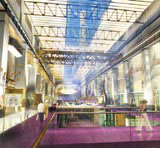GLA predicts paucity of retail space for London

Despite a number of large-scale shopping developments in areas including Stratford, White City and Battersea Power Station, London may need up to 150ha of extra retail space by 2016, according to a report commissioned by the Greater London Authority.
Existing plans for retail development will be insufficient to meet the demands of a rising population, says Martin Davies, director of retail consultancy at Experian, the company that conducted the study. The report predicts that between 30ha and 200ha of additional floorspace may be needed, depending on the growth of stores’ sales density.
London mayor Ken Livingstone will use the report to inform planning decisions throughout the city. He is aiming to create sufficient choice without damaging the retail centres of local areas, according to a spokesman for the GLA.
‘The growth would be accommodated in existing local town centres, not out-of-town shopping centres,’ he says. ‘It is less about creating new centres and more about making better use of existing ones.’
Projects already on the table include Hong Kong developer Parkview International’s retail and leisure complex in and around the iconic Battersea Power Station. The building itself commands an area roughly the size of Trafalgar Square and is accompanied by 15ha of ancillary space. Of this, more than 4ha have been set aside for ‘luxury’ retail in the building’s Turbine Hall A (concept pictured).
The Battersea development is expected to commence in 2007 and is forecast by Experian to attain goods expenditure of around £500m.
At Elephant & Castle, the tired shopping and transport hub in south London, a £1.5bn regeneration programme is underway. This will unlock 7.5ha of retail space under the ten- to 15-year Southwark Council programme.
Other areas of London retail development include White City, Wembley, Kings Cross and Canary Wharf. Experian claims that almost half the additional space needed is for central London and about 20 per cent is for south London; the remainder is split equally between the remaining regions.
‘If they are going to find a way of [creating the extra space], they should go where the people are moving – East down the river at a pace,’ says Steve Collis, joint managing director of retail design consultancy JHP Design.
Collis also believes that out-of-town centres are no longer particularly desirable and a combination of converting existing buildings and nurturing ‘village mini-centres’ in provincial London is a preferable strategy.
‘London is a vast city and heavily centred areas are not working. It’s about creating the feel that something is happening in the local areas, so that people don’t feel they need to visit Harvey Nichols or Selfridges. In the very centre there are many courtyards and gaps, such as [Soho’s] Kingly Court, that can be reworked for retail,’ he adds.
-
Post a comment




